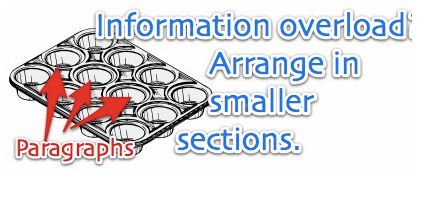Week 10: Assignment 3, the close one-article review
Warm and likely a spring storm today.
Let's start with some due dates:
- Tonight! Last ER Reviewing Task for the coffee cup memo. GET IN THERE.
- Friday, I open up the coffee cup parking lot and you have one week.
- Friday, I will also open up a short assignment for your article review, Assignment 3
- You will need the abstract of your desired piece.
- Number 3 means you have an article now or will have one by Friday. Must be peer reviewed article of your choice. For comp sci/data sci students, please email me because your field publishes differently than many expert disciplines.
- I will fill out the April to May ELMS calendar for Assignment 3. And, debut two ways to complete:
- Train A to complete early (close to the last day of class)
- Train B to complete midway through finals.
Now, on to more work thinking about transitions between paragraphs and even document sections. We have two metaphors for this. First up? muffin tin.

In the muffin tin metaphor, we chunk information into the tins, which is natural and good. We divide complex information to conquer the complexity. Doing this heaving cognitive lifting is necessary for analysis and even uses of the information. However, muffin tin "scoops" of information are largely the type of information that is joined by the conjunctive and. We have yet to introduction the powerful (also wakes up reader cognition) conjunctives of but (however) and or (contrast or choices or options). We have yet to introduce the power of therefore, where we create meaning and actions based on meaning. See the video below from Randy Olson.
One of Aristotle's canons for writing is ARRANGEMENT. The order and "chunking" of information matters very much for reader cognition and receptivity to what you write.
Now, the (Lego) train metaphor, where the cars are different, helping us think about and, but, or, and toward the end (caboose) of therefore.

Now, to the exciting and somewhat potty-mouthed Randy Olson, marine biologist, filmmaker, and science communication evangelist. (NOTE: Video fixed at 3:20, Monday)
Randy's work is the and, but, therefore framework, which we call ABT.
Let's think a bit about peer reviewed research articles and link this topic to ABT statements/framework:
- This google slide set about the research article.
- Keep a running grid on your reading. Copy this google doc to your drive. Reading IS essential to writing. Again, this is part of my case for labor grades. ABT statement is previewed here.
Happy Wednesday.
We will pick up links from Monday to
- consider the most common type of science/tech article
- hear more from Randy Olson the potty-mouth guru of science writing
- look at examples of ABT statements
- NEW to you: slide set of ten samples from a workshop at UMCP with Olson (environment discipline) PLUS a set of medical humanities ABT workshoping in a Google Doc.
- Keisha Barr, with Randy Olson, on the "narrative gym" frame of ABT and IMRAD work (7 sldies, highly visual)
Friday! Necessary rain, so my plant scientist/gardener heart rejoices.
Will be here, as per usual,
- 9-9:50
- 11-11:50.
(mini lesson: when do you use numbers and when do you use bullets? Numbers help with order matters.)
You have TWO -- count 'em, two -- ER Writing Tasks now live and "due tonight. Here is how to think about what is due for realz and what is due over a week (hint: parking lot metaphor):
- ER WRITING TASK for prewriting Assignment 3, the close review of your selected article
- ER WRITING TASK for a parking lot approach for Assignment 2, for a grade.
(Mini lesson: order matters or can matter in bullets. Note that I put your PRIORITY ER WRITING TASK first in the bulleted order; this suggests that this task takes priority over the "parking lot" task.)
Song of the day (what is the greener disposable hot beverage cup?):
More Kermit in our lives and way less (let's just say no amount is health for children and other living things) Pepe the frog.
